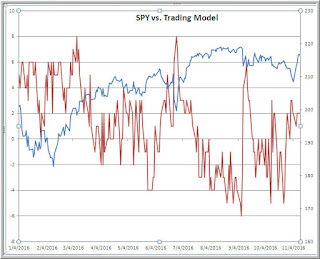Above is an update of my ensemble trading model, which combines individual predictive models for SPY over a 10 day horizon. The individual models include measures of buying and selling pressure, institutional participation, volatility, breadth, sentiment, and cycle status. The best signals occur at +3 and above and -3 and below; we currently stand at +2, with a mildly bullish bias. We had +3 readings on 11/1 and 11/2 and, despite considerable election-related volatility since then, we stand meaningfully higher at this point.
At present, breadth has been expanding, in no small part due to the strength of small cap stocks since the election. We have also seen selective strength among sectors, most notably the financial and industrial sectors deemed to benefit from the new administration. Stocks making fresh three-month highs have expanded to their greatest level in many months. It's exceedingly rare for such expanding breadth to suddenly reverse and morph into a bear market. Rather, these momentum phases of a cycle tend to fade away, with decreasing volume and volatility and divergences of new highs, as value investors no longer perceive value and pull back from segments of the market. I would expect the model to turn bearish should volume and volatility pull back and should we see diminishing institutional participation on any further strength.
Meanwhile, the model components contributing to the modestly bullish current reading include sentiment, institutional participation, and buying pressure. In a nutshell, sentiment (adjusted for volatility and recent price movement) has been unusually bearish; participation has been quite high; and a growing proportion of that participation has been channeled toward buying. Those dynamics have had me in the mode of buying dips. Equally important, the model readings have prevented me from fading strength, which I've seen a number of traders doing, perhaps caught up in a bearish bias related to the election result. The psychological value of a well-constructed trading model is that it imposes the discipline of patience. Instead of assuming that I have an edge in trading, the model tells me when the market is affording edge. That's an important distinction that takes a lot of ego out of trading. Once we realize that edge is a function of opportunity set in the market, we can flexibly adapt to changing market conditions.
Further Reading: Quant Models and Trading Psychology
.
At present, breadth has been expanding, in no small part due to the strength of small cap stocks since the election. We have also seen selective strength among sectors, most notably the financial and industrial sectors deemed to benefit from the new administration. Stocks making fresh three-month highs have expanded to their greatest level in many months. It's exceedingly rare for such expanding breadth to suddenly reverse and morph into a bear market. Rather, these momentum phases of a cycle tend to fade away, with decreasing volume and volatility and divergences of new highs, as value investors no longer perceive value and pull back from segments of the market. I would expect the model to turn bearish should volume and volatility pull back and should we see diminishing institutional participation on any further strength.
Meanwhile, the model components contributing to the modestly bullish current reading include sentiment, institutional participation, and buying pressure. In a nutshell, sentiment (adjusted for volatility and recent price movement) has been unusually bearish; participation has been quite high; and a growing proportion of that participation has been channeled toward buying. Those dynamics have had me in the mode of buying dips. Equally important, the model readings have prevented me from fading strength, which I've seen a number of traders doing, perhaps caught up in a bearish bias related to the election result. The psychological value of a well-constructed trading model is that it imposes the discipline of patience. Instead of assuming that I have an edge in trading, the model tells me when the market is affording edge. That's an important distinction that takes a lot of ego out of trading. Once we realize that edge is a function of opportunity set in the market, we can flexibly adapt to changing market conditions.
Further Reading: Quant Models and Trading Psychology
.





